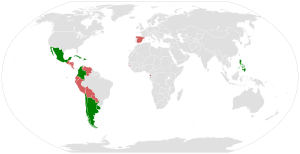Peso facts for kids
The peso is the name of the money used in several Spanish-speaking countries in Latin America, and also in the Philippines. The word peso comes from Spanish and means "weight."
Many countries in the Americas use the "$" symbol for their peso. This symbol was originally a short way to write "pesos." Later, the dollar also started using this symbol. The dollar itself actually came from the peso, or Spanish dollar, a long time ago. In the Philippines, they use a special symbol: "₱."
The silver peso coin, which was worth eight reales, was also known as a Spanish dollar or "piece of eight." It was very important for international trade from the 1500s to the 1800s.
Contents
The Peso: A Global Currency
The Story of the Peso
The Famous "Piece of Eight"
The name peso was first given to a silver coin introduced in 1497. This coin was worth 8 reales. It was made from silver found in places like Mexico, Peru, and Bolivia in the 1500s. Soon, this coin became very important for trade all over the world. It connected Europe, Asia, and North America.
At first, these peso coins were made quickly in Spanish Latin America. Workers would cut a piece of silver from a bar. Then they would flatten it and stamp it with a hammer. These early coins were rough and uneven. They were called cobs in English or macuquina in Spanish. Because of their irregular shape, they were sometimes cut or copied.
Later, around 1728, laws were made to improve the coins. New machines started making pesos perfectly round with special edges. This made them harder to fake and easier to use. These improved coins became even more popular for international trade. People trusted their value. They preferred to use them as coins rather than melting them down.
English colonists in North America called this coin a piece of eight or a Spanish dollar. In other languages, it had names like piastre (French) or pataca (Portuguese).
The Mexican Peso's Global Journey
After many Spanish colonies in America became independent in the early 1800s, the supply of Spanish silver coins changed. By 1825, the Spanish dollar was no longer the only major coin. However, the peso, especially the one from Mexico, continued to be very important.
Mexico became a huge producer of these coins. They were often called "Mexican dollars." These coins were widely used in trade, especially in Asia. For a long time, the Mexican dollar was even more common in international trade than the U.S. dollar.
In the late 1800s, Mexico tried making a new peso coin. It was perfectly round and had "Un Peso" written on it. But some merchants, especially in China, preferred the older, slightly irregular "eight-real peso." So, Mexico went back to making the older style for a while.
However, around this time, many countries started using gold instead of silver for their money. This caused the value of silver, and thus the Mexican dollar, to drop. Even so, Mexico produced billions of these coins between the 1500s and 1800s. This made them truly global money.
The Philippine Peso's Beginning
The Philippine peso (called piso in Filipino) also came from the Spanish dollar. This Spanish silver coin was used a lot throughout America and Southeast Asia for centuries.
Before 1852, the Philippines didn't have its own official currency. People used pesos from Spain and Spanish America. Then, local pesos started to appear:
- In 1852, the Banco Español-Filipino de Isabel II (now the Bank of the Philippine Islands) began printing Philippine peso fuerte banknotes.
- A mint was opened in Manila in 1857. Gold peso coins were made starting in 1861.
- Silver coins (50, 20, and 10 centimo) were also minted starting in 1864.
Like the Mexican dollar, the Philippine peso was based on silver. When silver's value dropped in 1873, the Philippine peso's value also went down. By the end of the 1800s, it was worth about half of a United States dollar. Even after the Philippine Revolution in 1896 and the declaration of independence in 1898, the name of the currency stayed the same.
Countries Using the Peso Today
Current Users
Many countries still use the peso as their official currency. Here are some of them:
| Country | Currency | ISO 4217 code |
|---|---|---|
| Argentine peso | ARS | |
| Chilean peso | CLP | |
| Colombian peso | COP | |
| Cuban peso | CUP | |
| Dominican peso | DOP | |
| Mexican peso | MXN | |
| Philippine peso (piso) | PHP | |
| Uruguayan peso | UYU |
Countries That Used the Peso Before
Some countries used the peso in the past but have since changed their currency. Here are a few examples:
| Country | Former currency | Final Year | Current currency |
|---|---|---|---|
| Bolivian peso | 1986 | Bolivian boliviano | |
| Costa Rican peso | 1896 | Costa Rican colón | |
| Cuban convertible peso | 2020 | N/A | |
| Ecuadorian peso | 1884 | United States dollar | |
| Salvadoran peso | 1919 | United States dollar | |
| Bitcoin | |||
| Equatorial Guinean peso | 1975 | Central African CFA franc | |
| Guatemalan peso | 1925 | Guatemalan quetzal | |
| Guinea-Bissau peso | 1997 | West African CFA franc | |
| Honduran peso | 1931 | Honduran lempira | |
| Nicaraguan peso | 1912 | Nicaraguan córdoba | |
| Paraguayan peso | 1943 | Paraguayan guaraní | |
| Peruvian peso | 1863 | Peruvian sol | |
| Puerto Rican peso | 1900 | United States dollar | |
| Spanish peso | 1869 | Euro | |
| Venezuelan peso | 1874 | Venezuelan bolívar |
See also
 In Spanish: Peso (moneda) para niños
In Spanish: Peso (moneda) para niños


